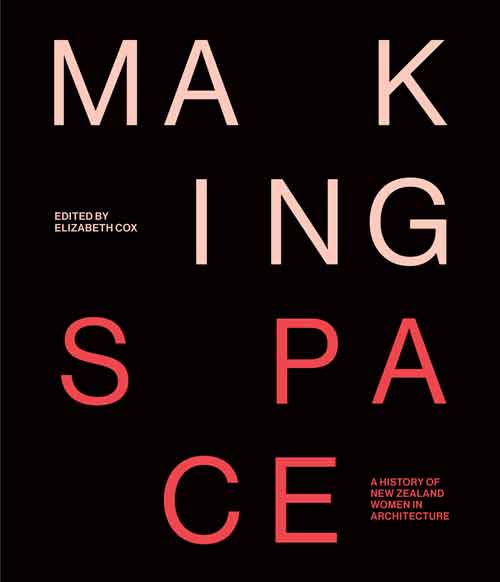Review: Making Space: A history of New Zealand women in architecture
Reviewed by Penny Lewis
g Space is an impressive recent release billed by its publisher Massey University Press as ‘a new book that sets the architectural record straight.’ The title says it all – Making Space recognises and records women’s contribution to architecture in New Zealand, the significant acknowledgment of which has been lacking so far. Almost unbelievably, it took until 2022 for a woman to win the New Zealand Institute of Architects’ Gold Medal, when Julie Stout took home the NZIA’s highest honour.
Making Space is very much an industry book but any reader interested in history, women’s lives and issues facing women working in architecture today will find much to explore. The substantial 448-page tome has been produced with the support of Architecture+Women NZ and Te Kāhui Whaihanga New Zealand Institute of Architects among others.
I particularly enjoyed my first glimpse of its cover. Forget about soft pastels, smiling faces, pretty illustrations or other traditional tropes to indicate this is a book about women. Making Space looks direct, emphatic, elegant and of Aotearoa. There are no photographs or illustrations on the bold, red cover or its mainly black folded-flap sleeve. With no-nonsense cover type in sans serif capitals, Making Space is a book that means business but appropriately, it’s also beautiful to look at and wander through.
Like good architecture, Making Space has substance to its style. Its editor, Wellington-based historian Elizabeth Cox, specialises in both architectural and women’s history and is a trustee of the Futuna Chapel in Wellington, the late architect John Scott’s seminal work. She has done a sterling job editing substantial contributions from 30 architectural historians, academics and women working in architecture.
Cox explains in publicity notes that the book is called Making Space because she saw women making physical spaces and also making space for themselves within the profession: ‘But a third meaning of the book became clear as I was working with everyone on their chapters – that the book itself was making a space for women to write and think about their profession and their experiences, and to have hundreds of conversations about architecture with their peers.’
Making Space is divided into three sections, with part one covering the period 1840-1945 and part two examining 1945-2000. The heftiest section, part three, spans 2000 until 2022. Leading into each section is a summary of what’s covered, which helps to recognise overarching themes and make sense of the rich content.
Making Space is an important book, one that anyone interested in architecture should own.
Academics or someone working in architecture may wish to read the book in order but as a lay person I found myself dipping in and out. The dipping approach doesn’t seem to matter as each chapter is self-contained but connected. After all, historical events and moments in people’s lives are seldom linear.
Making Space is dedicated to Lucy Greenish (Symes) 1888-1976. Greenish was the first woman to register as an architect in New Zealand in 1914, 20 years before the next woman did so. Cox writes in the introduction to Making Space how the idea for the book came to her when she saw Greenish was the only female included in 300 architect biographies in a 2014 book on architecture in Wellington between 1840 and 1940.
Wishing to find out more about Greenish, Cox delved into the NZIA’s early records from the 1910s to the 1940s, including boxes of NZIA registration applications, which practitioners have had to do since 1913 in order to use the title of ‘architect.’ Cox discovered more than 20 other women’s names in the documents. But, as she writes in Making Space, ‘The standard architectural narrative in New Zealand, however, is that there were no female architects working in the first half of the twentieth century.’
Making Space shakes up this narrative and then builds on it, with more than 400 photos and mentions of more than 500 women. Many stories are biographical and fascinating, looking into personal lives as well as professional ones. I found Greenish’s story particularly poignant, with events in her personal life that must have been very difficult to bear.
Of course, during the decades many women have struggled working in architecture and their stories are diverse. The benefit of 30 writers contributing to Making Space means a variety of perspectives are represented, either their own experiences or those of wāhine they’ve interviewed.
In part three of the book, I found Ekta Nathu’s essay, The Burden of Translation: Women at Architecture School 2000-2020 particularly thought-provoking. Nathu is an architectural graduate who works as a school design advisor. She spoke with 16 Māori, Samoan, Tongan, Chinese, Indian, Jamaican and Pākehā female recent graduates about their experiences of architecture school and the extra hurdles faced by women of colour.
Subsequent essays by excellent writers in the 2000 to 2022 section explore life in architecture practices, activism and wāhine Māori and Pacific architects. The section also showcases women working in sustainability, heritage and academia, designing large commercial, health, educational, cultural and residential buildings. It also covers women working in landscapes, urban design, co-housing, and papakāinga (housing on ancestral Māori whenua). Women working on the post-earthquake recovery of Canterbury are also represented.
Making Space is an important book, one that anyone interested in architecture should own. I reckon every architecture practice in the country should stock up on at least a couple of copies – one for architects to refer to regularly and another for clients to read in reception.
Here’s hoping the publication of Making Space provides a solid foundation on which to continue documenting the story of New Zealand women in architecture. With women making up half of architecture-school graduates, it’s certainly about time.
Reviewed by Penny Lewis
